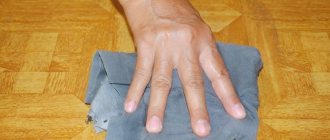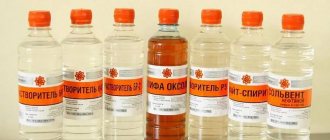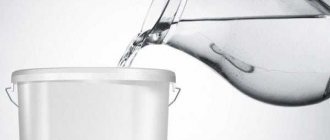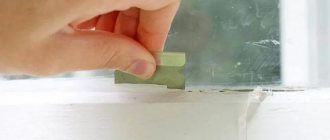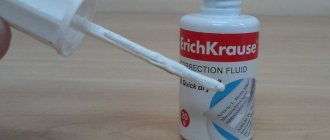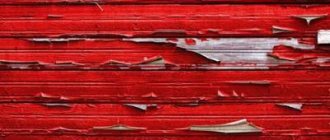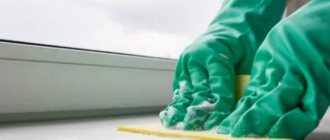According to most experts, acrylic paints are the most convenient to use. This is the secret of their popularity. In addition, they are distinguished by bright, rich colors.
This is one of the most popular artistic materials among painters, students, designers and decorators, and for good reason, this is due to their versatility and unique properties.
Their main component is water, so the drying speed of the composition applied to the surface is much higher than that of other types of dyes. But this ability can become a problem. You have to think about how to dilute acrylic paint for painting and walls, so that when you apply a layer, its color completely matches the color of the newly purchased can. On topic: how to dilute oil paint.
Acrylic paint composition
The basis of this coating is formed by the following components: pigment, binder, water. The material that acts as a binder is of synthetic origin. It is called an emulsion formed by polymer acrylics.
The secret to quick drying isn't really that. The water evaporates very quickly and a film is formed that covers the entire surface to be painted. The solution itself is resistant to low temperatures, does not delaminate or crumble.
All funds can be divided into groups depending on:
- scope of application;
- ability to withstand various physical influences;
- whiteness level;
- the shine of the coating.
Acrylic mixtures are successfully used for finishing interior and exterior substrates. They can be divided into universal and combined. Among the coatings produced, there are samples with various properties, for example, resistance to moisture, light, or mechanical damage.
The scope of application is very wide, and is not limited only to construction and repair work. They are widely used in their work by famous artists and amateurs.
They can be used to beautifully paint glass, paint plastic, aluminum, or apply a design to a ceramic surface. Create a high quality image on leather, paper, canvas. All other paintwork materials are very limited in their application. They are narrowly profiled. For example, only for painting brick, concrete, plaster, wood or varnished surfaces.
ON A NOTE! In order to obtain high-quality coverage of all surfaces in a room with optimal temperature and humidity, it is necessary to use a certain type of acrylic. It fits freely both on plaster and on surfaces with relief and drywall.
Acrylate ceiling paint: advantages
Acrylate paint is the flagship of the world market for the production of painting products, which have already reached the international export level and are one of the best and most sold in our region.
Many people prefer to choose acrylate paint as it is safe and helps protect the ceiling from mold and other bacteria.
This paint has a lot of advantages:
- The material has an antiseptic effect, which helps protect the room from mold and high humidity.
- A wide palette of colors will allow you to choose any desired shade.
- The dyes are applied in a fairly uniform and thin layer, which allows great savings on consumables during repairs. Paint consumption, according to average calculations, is about 120 g / 1 m2.
- The paint is as convenient as possible, as it adheres perfectly to any surface, and its complete drying takes no more than 3 hours.
- Convenient pricing policy, which, by the way, is not cheap, is compensated by the high wear resistance of the paint. It has a long depreciation period, a smooth, matte texture with a slight hint of gloss, and the manufacturer itself provides a warranty of about 3-4 years.
Many manufacturers of acrylic paints, for example Tikkurila, can boast of similar advantages.
How to dilute acrylic paint?
The question is very interesting and often arises among those who have to deal with this type of product for the first time. The situation when it is necessary to dilute the contents of a jar with the composition occurs very often. The question is: what caused this need?
The product itself has a fairly thick consistency, which cannot create problems during the paint application process. In this case, the product is distributed very unevenly over the surface. If the jar has been left for a long time without a lid, then its use without additional dilution becomes impossible.
Another condition when breeding must be carried out is the use of acrylic for restoring furniture or creating an artistic canvas. When using a solution that has a very thick consistency, traces of a paint brush or roller remain on the surface.
We can say that the structure of the surface is disrupted, and it becomes not smooth, but has flaws, which in turn is very noticeable.
Since all acrylic dyes are based on water, it is quite natural to assume that the main solvent for them will also be water. This is a very interesting fact, since after complete drying, the film formed by the emulsion does not allow water to pass through at all. Therefore, all tools and containers used during painting should be cleaned before everything dries.
Manufacturers, in addition to water, suggest using a number of other substances. But their names and method of use can only be found in the instructions supplied with the container with the composition. All of these solvents have the ability to change some properties. Most often, they have the ability to give the painted surface a gloss or matte finish. These are qualities that are not available to plain water.
RECOMMENDATION! When choosing a product, you need to carefully read the instructions and find out how to dilute acrylic paint for painting and all the existing features of application for ceilings and walls.
Features of acrylic
Acrylic paints are a type of water-based solutions. They are produced in the form of a thick consistency of various colors. In order for the solution to be applied evenly to the surface of the material, it should be diluted beforehand. Acrylic paint consists of several components:
- Dye. The pigments are various types of powder, which are crushed into very small particles. This element is made from natural or synthetic substances.
- Acrylic resin. It is used to connect all components together. It is the resin that, after drying, forms a durable film that holds the pigment on the surface of the material.
- Solvent. Many manufacturers use ordinary water for this. But some types of acrylic paints are made based on organic solvents.
- Fillers. Various substances are used here that can change the physical and decorative properties of paints. With their help, acrylic is given strength, durability or resistance to moisture.
Using water as a solvent
The simplest situation is when the mixture has to be diluted with water. But this important manipulation is not carried out “by eye”. This requires precise adherence to proportions, otherwise problems may arise. It is very difficult to correct the consequences of such actions.
Therefore, before starting work, you should carefully read the recommendations contained in the instructions. There is always information about the required ratios of water and solution for high-quality dilution. If all the rules are followed, the coloring matter of the required consistency is obtained. In this case, all product properties will remain unchanged.
There are also specific requirements for water, which is supposed to be used as a solvent. It must be clean and cold. Do not dilute the entire jar at once. It is much safer if only a small amount is diluted. This way you can empirically calculate the volume of water required for the entire container. Especially if not the entire volume of dye is used.
The process of determining the mixture to water ratio requires two things. An ordinary pipette and a small bottle for any drops. Most often, dilution is carried out in a ratio of one to one, less often one to two, one to five or one to fifteen.
The resulting consistency has its own characteristics:
- The ratio is one to one. The resulting consistency is most suitable for creating a base layer. It has a fairly high degree of density, but at the same time it is easy to lay on the surface to be painted, spreading over it in a neat, even layer.
- The ratio is one to two. The result is acrylic that is more liquid than in the first case. It is just as easy to lay on the surface, but the resulting layer is thinner.
- The ratio is one to five. At this amount, the water content in the paint is significant. The resulting colorant is more similar to colored water. Having this consistency, the product easily penetrates between the bristles that form the brush. The layer of emulsion applied to the surface has a lighter shade compared to the original one. Texture details are usually treated with this solution, since the liquid contents of the jar are easily absorbed and do not linger on the protruding parts of the surface. We recommend reading: how to paint wallpaper for painting.
- The ratio is one to fifteen. In this proportion, the solution is closer to water, containing only a small part of the pigment. With this consistency, it is used to create a smooth color transition between two tones. Or to create a color gradient.
REMEMBER! Oxygen is harmful to these products. The more often you open the jar, the faster it dries. Therefore, it is recommended to open the container immediately before use.
How to dilute with water
Since water is part of the paint, it is possible and even preferable to dilute it. As a rule, 4 proportion options are used:
- 1:1 - normal consistency, quite thick, used for the base layer, the paint applies evenly, without drips;
- 1:2 - more liquid, optimal for painting openwork parts or for painting with impregnation;
- 1:5 - consistency close to “colored water”, suitable for textured and relief surfaces, including vinyl wallpaper for painting, bas-reliefs, etc.,
- 1:15 - colored water, used to create gradients, toning, etc.
Water should be poured in a thin stream, stirring constantly and achieving an absolutely uniform paint structure. A construction mixer will be superfluous; a rod, stick or wooden plank is enough, but you need to move it quite intensively.
Water + alcohol
In some cases, when the paint has become particularly thick, it can be diluted with water mixed with alcohol. Such a coating will dry somewhat faster due to volatile alcohol, however, the quality of the layer will be worse.
Nuances of the process of diluting acrylic paint
Very often, water contains additional chemical elements and chemicals that, when diluted, can affect the quality of the acrylic. Therefore, it is best if the water used to prepare the dye is allowed to sit for several hours.
During operation, the product may come into contact with surfaces not intended for painting. In this case, before it dries, it can be easily removed with water and a cloth. On topic: how to remove paint from clothes.
It is very convenient to apply the product using a spray gun. The coloring material used in this method must have a uniform consistency and be of high quality. For these purposes, it is best to choose products from the most famous manufacturers. Only if this condition is met, the application of the layer will be carried out efficiently. It is better not to use water at all as a solvent, but only the substances recommended in the attached instructions.
Solvents can be selected in such a way that they can change the appearance of the applied layer. It is unacceptable to use substances not specified in the manufacturer's instructions as a solvent. In this case, the company that released this product to the market cannot guarantee the quality of the resulting paint layer. All imperfections will become noticeable after the surface has dried or a little later during service.
The solvent should be added slowly with constant stirring.
It is very convenient to use a construction mixer to mix the emulsion and solvent. If necessary, you can change the original color. For these purposes, special colors are used. If you add it to paint in small quantities, you can get any color and shade. The result obtained is best determined on the surface intended for painting. To obtain the result, a thin layer of paint is enough. If the resulting shade does not match, another color is added.
Thinner or solvent?
Very often, novice craftsmen substitute concepts such as thinner and solvent. To get the desired effect when painting with acrylic paints, you need to distinguish between them. Otherwise, the dye can only be thrown away. So, what are the differences between these compositions:
- If you add solvents to acrylic paint, its properties will change. This will be the reflectivity of the painted surface, as well as the speed at which the coat dries. In addition, using solvents, paint is removed from those places where it has dried.
- Paint thinners do not affect their properties. With their help, only the consistency and, accordingly, the saturation of the color change. You can achieve the effects of a translucent layer and a textured coating. To dilute acrylic-based enamels, use water.
How do you dilute dried acrylic paints?
Due to the fact that acrylic dyes contain water, they dry out very quickly. This quality is not always useful. Products in a container that is not tightly closed may lose water. Because of this, the consistency of the substance will change. When the water completely evaporates, the paint polymerizes.
- It is very difficult to return the contents of the jar to its original state, but it is quite possible to make such an attempt, but only if a sufficient amount of water is retained in the product. If there are small clots in the contents of the container, and the solution has not completely thickened, there is hope to fix everything. To do this, you need to add a little suitable solvent recommended by the manufacturer or water along with alcohol.
- In case of severe drying, you can try grinding the product into powder, adding a small amount of boiling water and draining it after a few seconds. Then do this procedure again. All this is done to ensure that the composition warms up well. After the third time, the boiling water is not drained, but left in a jar, which needs to be stirred thoroughly.
The emulsion brought back to life in this way will no longer be of the same quality as before it dried. There will still be some lumps in it. Because of this, the applied layer will be less durable.
NOTE! It is better to throw away a very dried solution, which is a lump, immediately, since you most likely will not be able to get anything useful from it. You can proceed as in the method indicated above, only after the second time, not boiling water is added again, but water with alcohol. The quality of this reclaimed paint will be very poor.
Causes of drying out
Thick acrylic paint is quite common, as manufacturers produce it in this form. But its service life is limited by time. The only reason for this composition to dry out is the evaporation of the solvent. A decrease in its concentration leads to hardening of the acrylic resin, which at the same time begins to bind the pigment.
To eliminate this phenomenon, it is advisable to buy only the volume of the mixture that you completely use. If the solution remains, try to close the lid tightly. This will minimize the evaporation of water or solvent and it will remain inside the paint.
If the paints are completely dry, you can try to revive them. This process is quite simple and involves several sequential operations:
- Initially, you need to thoroughly grind the dry solution.
- After this, boiling water is added to it. An alternative could be a water bath. But technically these are the same algorithm.
Please note that after restoration, acrylic paint will lose its original properties. Therefore, it can only be used in limited places.
Features for creating wall paintings
For painting on walls, products are available packaged in small boxes. They are suitable only for decoration and artistic painting. Also, many artists like to use them to create paintings on canvas.
The rules for diluting such mixtures are very different from those established for acrylic dyes intended for large surfaces.
In this case, a pipette is also used to determine the required ratio. The composition is diluted using a palette, both dry and wet. You can use special caps for these purposes.
A damp palette works best. The speed of drying depends on its humidity. The ratio of water and product depends entirely on the desired shade of the mixture. The lighter it is, the more water needs to be added. If you need a rich, bright color, the ratio will be one to one.
Traditional methods of application
To do this, use brushes, rollers, and a spray gun. The working tool is chosen depending on the surface to be painted; its structure and area play an important role. It should be remembered that the shade of the applied mixture will be slightly different from the shade that has already dried. Therefore, you should not rush and always check the final color of the resulting coating. We recommend that you read the review: how to get purple color from paints.
Very often it becomes necessary to dilute an additional amount of a product of exactly the same shade. To do this, leave a little composition at the bottom of the old jar to compare shades.
What to do if the paint has dried
It is impossible to accurately calculate the amount of material needed, so professional builders prefer to take it in reserve. After interior finishing, there are situations when some amount of paint remains unused.
The remainder in the jar gradually dries out - the moisture evaporates over time, and polymerization begins. The more liquid “leaves”, the lower the performance characteristics of the composition.
You shouldn’t immediately throw away the damaged material: you can try to revive the paint, returning it to its original properties.
Instructions for restoring dried paint.
Grind the remains into powder with a minimum fraction.
Pour boiling water over for 2-3 seconds , then drain.
Repeat the procedure 2-3 times so that the composition warms up.
Leave the boiling water in the jar and mix the contents thoroughly until smooth.
If the paint has turned into a homogeneous plastic lump, proceed as in the previous case. But at the final stage of resuscitation, add alcohol instead of hot water. Regular women's nail polish, added a little at a time, can also help.
If finances allow, buy acrylic thinner "Gamma" . It is inexpensive, but does an excellent job with paint that has acquired a “rubber” consistency. The product is sold in online stores and specialized retail outlets.
The performance properties of the restored material will be lower than the original ones - the lumps will not completely dissolve, which will negatively affect the strength of the coating. Use this composition for painting minor surfaces that are not noticeable.
If acrylic paint has deteriorated after improper storage, for example, at subzero temperatures, it cannot be restored. In such a situation, irreversible polymerization of the material begins, various substances will be powerless.
How to work with acrylic paints?
The most important thing when working is the preparation process. The better and sufficiently diluted the product, the better the result will be. Do not use very thick dye. There will be very noticeable marks from the roller or brush on the surface, especially after everything has dried. You can learn how to prepare walls for painting from our article.
IMPORTANT! Acrylic is a paint that requires careful dilution and equally thorough stirring. When diluting with a solvent, especially water, the recommended proportions must be strictly observed.
You cannot start your work without studying the instructions. If a film has formed on the surface of the contents of the jar, it must be completely removed. It is unacceptable to mix it with the rest of the paint, as this will significantly reduce the quality. If you plan to apply several layers, you need to pause between paintings to allow the layer to dry.
Application of acrylic thinners
Specialized formulations are also divided according to drying speed. The correctly selected option allows you to perform work even in difficult conditions.
The following varieties are found:
- Slow. Suitable for external and internal work if temperatures are very high. The fact is that due to the rapid evaporation of ordinary water, the coating does not acquire the desired properties and may be destroyed. And slowly evaporating thinners make it possible to perform the work correctly, as a result of which the surfaces receive reliable protection.
- Average. This is a universal composition, the best option for working inside a house or apartment.
- Fast. They are used mainly outside, including at low temperatures. In such conditions, the paint, with simple dilution, does not have time to adhere to the base, and a quick thinner solves this problem.
